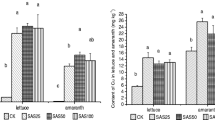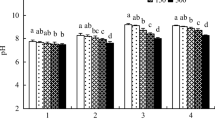Abstract
High Cd and Ni concentrations in sandy soils were built up in a field experiment, receiving an unusually metal-polluted sewage sludge between 1976 and 1980, at Bordeaux, France. The study evaluates the availability of metals and their after effects on maize at one point in time, the 8th year following termination of sludge application (1988). Plant parts (leaves, stalks, roots, grains) and soil samples were collected from plots which received 0 (Control), 50 (S1) and 300 Mg sludge DW ha−1 (S2) as cumulative inputs. Dry-matter yield, plant metal concentrations, total, and extractable metals in soils were determined.
Metal inputs resulted in a marked increase in total and extractable metals in soils, except for extractable Mn and Cu with either 0.1 N Ca(NO3)2 or 0.1 N CaCl2. Total metal contents in the metal-loaded topsoils (0–20 cm depth) were very often lower, especially for Cd, Zn, and Ni, than the expected values. Explanation was partly given by the increases of metal contents below the plow layer, particularly for Cd at the low metal loading rate, and for Cd, Ni, and Cu at the high one (Gomez et al., 1992). In a control plot beside a highly metal- polluted plot, Cd, Zn, and Ni concentration in soil increased whereas the concentration of other metals was unchanged; lateral movement, especially with soil water, is plausible. Yield of leaves for plants from the S2 plot was reduced by 27%, but no toxicity symptoms developed on shoots. Yields of stalks for plants in both sludge-treated plots numerically were less than the controls but the decrease was not statistically significant. Cd and Ni concentrations increased in all plant parts with metal loading rate while Mn concentrations decreased. Leaf Cd concentration in plants from sludge-treated plots (i.e. 44 and 69 mg Cd kg−1 DM for S1 and S2) was above its upper critical level (i.e. dry matter yield reduced by 10%: 25μg Cd g−1 DM in corn leaves, Macnicol and Beckett, 1985).
Yield reduction at the high metal-loading rate was probably due to 3 main factors: Mn deficiency in leaves, the accumulation of Ni especially in roots, and the increase of Cd in leaves. The amount of metal taken up by plants from the control plot ranked in the following order (mole ha−1): Fe(22)≫ Mn(7)>Zn (5.6)≫Cu (0.7), Ni (0.6), Cd (0.4). For sludge-treated plots, the order was (values for S1 and S2 in mole ha −1): Fe (16, 15)>Zn (7.9, 7.7)>Ni (4.3, 4.7)>Cd (1.9, 2.1)>Cu (1.0,1.2), Mn (1.5, 1.1). Zn and Cd had the greatest offtake percent from the soil to the above ground plant parts. Cd or Ni uptake by maize were correlated with extractable metals by unbuffered salts (i.e. 0.1 N Ca(NO3)2 and 0.1 N CaCl2). It is concluded that part of the sludge-borne Cd and Ni can remain bioavailable in this sandy soil for a long period of time (e.g. 8 yr) after the termination of metal-polluted sludge application.
Similar content being viewed by others
References
Afnor, 1986, Détermination du cuivre, manganèse et zinc. Extraction par l'acétate d'ammonium en présence d'EDTA. Norme X31–120, afnor Paris la défense, France.
Bell, P. F., Adamu, C. A., Mulchi, C. L., McIntosh, M., and Chaney, R. L.; 1988, Tob. Sci. 23, 33.
Bell, P. F., James, B. C., and Chaney, R. L.: 1991, J. Environ. Qual. 20, 481.
Bidwell, A. M. and Dowdy, R. H.: 1987, J. Environ. Qual. 16, 438.
CEC: 1986, Official Journal of the European Communities L181, 6. (86/278/EEC).
Chang, A. C., Page, A. L., and Warneke, J. E.: 1987, J. Environ. Qual. 16, 217.
Clijsters, H. and Van Assche, F.: 1985, Photosynthesis Research 7, 31.
Dirkzwager, A. H. and L'Hermite, P. (ed.): 1989, Sewage Sludge Treatment and Use: News Developments, Technological Aspects and Environmental Effects, Elsevier Applied Science, London.
Gomez, A., Solda, P., Lambrot, C., Wilbert, J., and Juste, C.: 1992, Bilan des éléments traces métalliques transférés dans un sol sableux après 16 années d'apports continus et connus de boues de station d'épuration et de fumier de ferme en monoculture irriguée de maîs, report 89-256, Ministère Environnement, Paris.
Hein, A.: 1988, ‘Die Nickel-Aufnahme von Pflanzen aus verschiedenen Böden und Bindungsformen und ihre Prognose durch chemische Extractionsverfahren’, PhD-Thesis, University of Goettingen.
Hinesly, T. D., Ziegler, E. L., and Barrett, G. L.: 1979, J. Environ. Qual. 8, 35.
Jackson, A. P. and Alloway, B. J.: 1992, ‘The Transfer of Cadmium from Agricultural Soils to the Human Food Chain’, in Biogeochemistry of Trace Metals, Lewis Publishers Inc., Boca Raton, FA, pp. 109–158.
Juste, C., and Solda, P.: 1985, ‘Effect of a Long Term Sludge Disposal on Cadmium and Nickel Toxicity to a Continuous Maize Crop’, in Processing and Use of Organic Sludge and Liquid Agricultural Wastes, Commission of the European Communities, D. Reidel Publ. Co., Dordrecht, The Netherlands, pp. 336–347.
Juste, C. and Mench, M.: 1992, ‘Long-Term Application of Sewage Sludge and its Effects on Metal Uptake by Crops’, in Biogeochemistry of Trace Metals, Lewis Publishers Inc., Boca Raton, FA, pp. 159–193.
Kelling, K., Keeney, D. R., Walsh, L. M., and Ryan, J. A.: 1977, J. Environ. Qual. 6, 352.
Larsen, K. E.: 1984, ‘Cadmium Content in Soil and Crops after Use of Sewage Sludge’, in Utilisation of Sewage Sludge on Land: Rates of Application and Long-Term Effects of Metals, D. Reidel Publ. Co., Dordrecht, The Netherlands, pp. 157–165.
Lubet, E., Plenet, D., and Juste, C.: 1989, Perspectives Agricoles 135, 77.
L'Hermite, P. (ed.): 1991, Treatment and Use of Sewage Sludge and Liquid Agricultural Wastes, Elsevier Applied Science, London.
Lübben, S., Rietz, E., and Sauerbeck, D.: 1991, ‘Metal Uptake and Crop Growth on Sewage Sludge Field Trials with Heavy Metal Contents near the Recommended Limit Values’, in Treatment and Use of Sewage Sludge and Liquid Agricultural Wastes, Elsevier Applied Science, London, pp. 535- 543.
Macnicol, R. D. and Beckett, P. H. T.; 1985, Plant Soil 85, 107.
McGrath, S. P.: 1987, ‘Long-Term Studies of Metal Transfers Following Application of Sewage Sludge’, in Pollutant Transport and Fate in Ecosystems, Blackwell Sci. Public., Oxford, pp. 301–317.
McGrath, S. P. and Lane, P. W.: 1989, Envir. Pollution 60, 235.
McGrath, S. P. and Cegarra, J.: 1992, J. Soil Sci. 43, 313.
Page, A. L., Gleason, T. L., Smith, J. E., Iskandar, I. K., and Sommers, L. E. (ed.): 1983, Utilization of Municipal Wastewater and Sludge on Land, University of California, Riverside, CA.
Sauerbeck, D. R. and Styperek, P.: 1984, ‘Predicting the Cadmium Availablity from Different Soils by CaCl2-Extraction’, in Processing and Use of Sewage Sludge, Commission of the European Communities, D. Reidel Publ. Co., Dordrecht, The Netherlands, pp. 431–434.
Sauerbeck, D. R.: 1987, ‘Effects of Agricultural Practices on the Physical, Chemical and Biological Properties of Soils: Part II — Use of Sewage Sludge and Agricultural Wastes’, in Scientific Basis for Soil Protection in the European Community, Elsevier Applied Science, London, pp. 181–210.
Sauerbeck, D. R. and Styperek, P.: 1988, ‘Heavy Metals in Soils and Plants of 25 Long-term Field Experiments Treated with Sewage Sludge’, in Agricultural Waste Management and environmental Protection, International Scientific Centre of Fertilizers, CIEC Belgrade, and Federal Agricult. Res. Centre, FAL, Braunschweig, Germany, pp. 439–451.
Sauerbeck, D. R. and Hein, A.: 1991, Water, Air, and Soil Pollut. 57–58, 861.
Van Assche, F. and Clijsters, H.: 1990, Plant, Cell and Environ. 13, 195.
Vlamis, J., Williams, D. E., Corey, J. E., Page, A. L., and Ganje, T. J.: 1985, Soil Sci. 139, 81.
Werner, W., Delschen, T., and Birke, C.: 1989, ‘Soil-Plant Relationships of Heavy Metals after Long-Term Application of Sewage Sludge’, in Heavy Metals in the Environment, CEP Consultants Ltd., Edinburgh, U.K., pp. 107–110.
Author information
Authors and Affiliations
Rights and permissions
About this article
Cite this article
Mench, M.J., Martin, E. & Solda, P. After effects of metals derived from a highly metal-polluted sludge on maize (Zea mays L.). Water Air Soil Pollut 75, 277–291 (1994). https://doi.org/10.1007/BF00482941
Received:
Accepted:
Issue Date:
DOI: https://doi.org/10.1007/BF00482941




